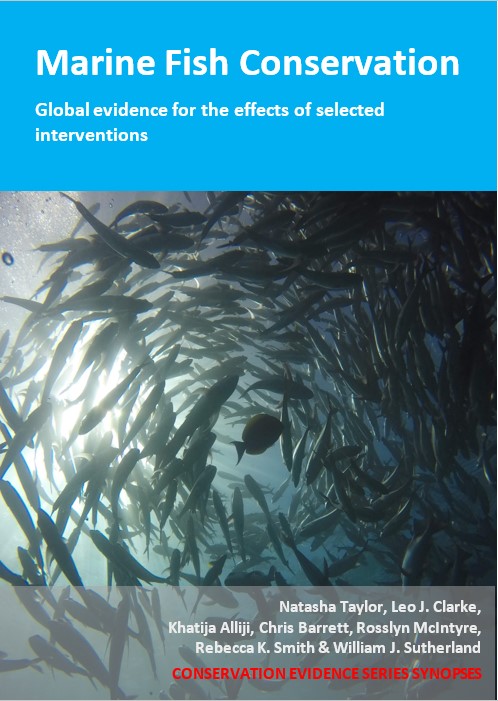Reduce the duration of exposure to air of captured fish before release
-
Overall effectiveness category Awaiting assessment
-
Number of studies: 3
View assessment score
Hide assessment score
How is the evidence assessed?
-
Effectiveness
not assessed -
Certainty
not assessed -
Harms
not assessed
Study locations
Supporting evidence from individual studies
A replicated study in 2000–2001 of bottom fishing grounds in the Bay of Biscay, Spain (Rodríguez-Cabello et al. 2005) found that reducing air exposure under commercial fishing conditions did not increase the survival of unwanted small-spotted catshark Scyliorhinus canicular, but it was increased under research fishing conditions. Catshark survival rates were similar between exposure times (sorting time on deck) on commercial trawling trips (20 min: 82%, 30 min: 80%, 40 min: 78%, 60 min: 68%, 85 min: 64%). However, survival rates were improved with shorter times on deck during bottom trawl survey deployments (20 min: 100%, 30 min: 94%, 40 min: 92%, 60 min: 81%). The authors noted that although a weak effect was found under commercial conditions, survival did not appear to be affected by sorting time or tow duration (data reported as graphical analysis). Data were collected from otter trawl deployments during commercial fishing trips (16 hauls) and bottom trawl surveys (20 hauls). For each deployment, groups of twenty catshark were exposed to air: for six intervals between 18–85 min during commercial deployments and 20, 30, 40 and 60 min intervals during the trawl survey. Tow duration was 180–360 minutes for commercial deployments and 30 minutes during the survey. After each period of time on deck after capture, catshark were transferred to onboard tanks and survival was assessed after 1 h.
Study and other actions testedA replicated study in 2015–2016 in two areas of pelagic water in the Gulf of Alaska off British Columbia, Canada (Cook et al. 2018) found that shorter durations of air exposure reduced levels of injury and improved physical condition of unwanted chum salmon Onchorynchus keta caught in purse seine nets. In both areas, salmon injury was lower and physical condition was better for shorter durations of air exposure during handling than longer (data reported as statistical model results). In addition, shorter holding times in the purse seine before retrieval were associated with improved physical condition (data reported as statistical model results). Experimental purse seining was carried out on two fishing trips targeting Pacific salmon Onchorynchus spp., in July-August 2015 and 2016. The effects of air exposure (1–12 min) and experimental holding times (4–43 min) on discarded chum salmon were investigated. Injury was scored based on scale loss, skin loss, wound depth and fin damage. Fish physical condition was scored according to the number of reflexes (e.g. burst swimming, orientation, eye movement, fight response and ventilation) that were impaired.
Study and other actions testedA study in 2014 in an area of coral reef on the Great Barrier Reef, Coral Sea, Australia (Raby et al. 2018) found that the overall behaviour of reef fish released after minimal air exposure was improved compared to longer air exposure. Average time spent immobile under the boat following release was lower after “low stress” handling with no air exposure than “high stress” handling that included air exposure for coral trout Plectropomus leopardus (low: 4 s, high: 9 s), emperor fish Lethrinus spp. (low: 0 s, high: 1 s) and Spanish flag snapper Lutjanus carponotatus (low: 0 s, high: 9 s). Time to reach the nearest reef was also lower (trout, low: 13 s, high: 19 s; emperor, low: 10 s, high: 19 s; snapper, low: 18 s, high: 33 s). Time taken to enter shelter was not affected by handling conditions, but varied with species (trout, low: 20 s, high: 24 s; emperor, low: 20 s, high: 135 s; snapper, low: 108 s, high: 130 s). In addition, fish subject to lower air exposure (all species) took less time to reach the ocean floor and exhibited higher tailbeat and ventilation rates (see original paper for data). In August-September 2014, a total of 62 fish were caught by hook and line from reefs 5–20 m deep and transferred to a 30,000 l tank. After 1–5 days, fish were transported by boat to a release site 8–12 m from the nearest reef. Fish were released after “low stress” handling (no forced exercise or air exposure) or “high stress” handling (1 min forced exercise, 5 min air exposure) to simulate capture by hook and line.
Study and other actions tested
Where has this evidence come from?
List of journals searched by synopsis
All the journals searched for all synopses
This Action forms part of the Action Synopsis:
Marine Fish Conservation





)_2023.JPG)














